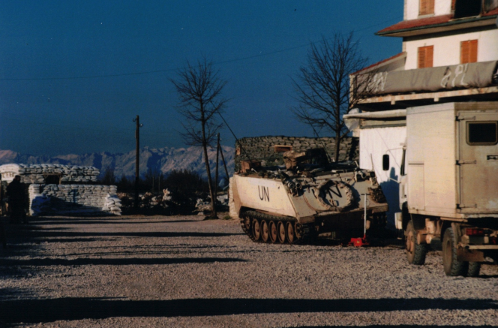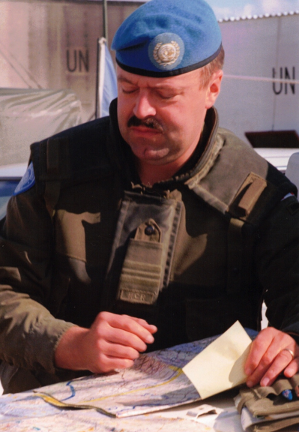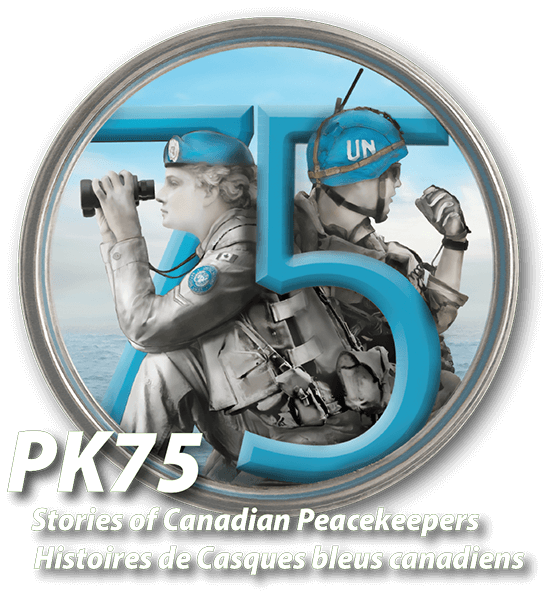

Kitchener, ON, Canada
Michael Jorgensen
Current Location: Kingston, ON, Canada
AN OPERATIONAL INITIATIVE WITH CONSEQUENCES
I returned from UN leave prior to New Year’s Eve, 1994, to hear my two-week period as acting Battle Group Commander would kick off with a tactical initiative on the last day of the year. The actual Battle Group Commander had left for his UN leave but had set in motion this initiative entailing the removal of three illegally established Krajina-Serb Observation Posts (OPs) from the UN protected area. The UN Protection Force Headquarters had tasked our nearly 800-member Battle Group from the 1st Battalion of The Royal Canadian Regiment to accomplish this task. I was thrilled to be in overall command of the Battle Group’s operations that day, and planned to be present at one of these sites 31 December 1994.
The operation involved the simultaneous, forcible removal of the OPs — each consisting of a 40-foot white accommodations trailer, minor entrenchments, and a 10-member section of armed, irregular military personnel. The operation was scheduled for first light, with cold conditions and a bit of fog to assist our covert approach. We first isolated each OP by cutting communications wires and employing other technical means. At each OP, Combat Engineers cleared an approach route of potential mines for a 30-member Infantry Platoon to use to approach the position. The Platoons deployed in Armoured Personnel Carriers but dismounted to surround the position and force the Krajina-Serbs — who had mainly remained inside the warm accommodation trailers — to exit unarmed and with their hands over their head.
Once these soldiers had been searched and secured, our troops secured the trailer and seized weapons and equipment found therein. Our soldiers cleared the trailers so quickly that they had to hand-carry out a wood-burning stove — still lit and smoking heavily, before the trailer could be prepared for transport. Our Military Police then documented our detainees and their weapons, while yet other Combat Engineers lifted the 40-foot trailers onto flatbed trucks for transport to our base compound, while additional heavy equipment restored the area to its natural state. The detained Krajina-Serb soldiers were delivered to their side of the DMZ, and their command structure advised of their location to ensure they were safely and quickly returned. This transpired quickly, and our troops were clear of the sites within an hour of the start of the operation — reflecting their tremendous professionalism and courage.
The operation’s success reflected careful planning and rehearsals. Our plans had remained secret, and surprise had been complete. Following the operation, we directed all elements of the Battle Group to return to their camps, given that we expected some reaction from the Krajina-Serb forces. Once we believed everyone to have safely returned to their bases, we completed our reports and proceeded to celebrate New Year’s Eve.
At the Battle Group HQ dining facility, I joined the two senior officers in our Camp — our anesthetist and surgeon. We had just finished loading our plates, filling our glasses, and moving to a table to propose a toast and start our meal, when a duty officer arrived to whisper in the ear of the surgeon that we had wounded personnel arriving. We ditched dinner and I sprinted to the Command Post (CP) to be brought up to speed — spotting en route an Iltis (4x4 wheeled vehicle) sitting at an odd angle by the Advanced Surgical Center, and clearly suffering from damage, including flat tires.
At the CP I learned that a group of Krajina-Serb soldiers had ambushed two of our soldiers as they drove through the Krajina-Serb-held town of Kolarina. These brave soldiers had suffered multiple gunshot wounds as they crashed through the ambush and had then driven approximately 13 kilometers on two flat tires, while bleeding and in pain! They were processed at the Advanced Surgical Center where I spoke with one of them shortly after passing orders to the various sub-units of the Battle Group over the command net radio. We notified their next of kin — no mean feat, given that it was New Year’s Eve back in Canada. We focused on accounting for all personnel, and adopted the appropriate tactical posture in response to this serious attack — including meeting with the senior “Corps Commanders” of the forces we knew to be responsible.
Both soldiers recovered from their wounds, including Master-Corporal John Tescione who was airlifted for further medical treatment in the following days. The driver, Private Phillip Badani, received the Meritorious Service Medal, and was recognized as Peacekeeper of the Year by the UN. Both continued to serve the Canadian Armed Forces. The vehicle, bearing nearly 60 bullet holes, was displayed in the Canadian War Museum as testimony to the risks of Peacekeeping Operations.
Biography
Brigadier-General Mike Jorgensen (Retired) has served 37 years in the Canadian Armed Forces. An Infantry officer with The Royal Canadian Regiment, he served with all three battalions of the Regiment as well as the Canadian Airborne Regiment. He has completed the U.S. Army Ranger Course. He commanded at every rank level — including command of P Company (a mechanized infantry company) in Germany, as a Major; the 3rd Battalion The Royal Canadian Regiment as a Lieutenant-Colonel; the Army’s Combat Training Center as a Colonel; and, the Canadian Army’s Land Force Western Area (one of the Army’s four Regional Commands) as a General Officer.
Mike served in various Headquarters and training posts — including G3 (Senior Operations Officer) of the 2nd Canadian Mechanized Brigade Group; Directing Staff at the Canadian Land Force Command and Staff College; Director Army Training; Director Professional Development at the Canadian Defence Academy; Assistant Chief of Staff J5 Plans at NATO’s Allied Joint Force Command in Brunssum (the Netherlands); and Chief of Staff to the Vice Chief of the Defence Staff of the Canadian Armed Forces. He also completed the National Security Studies Program at the Canadian Forces College.
BGen Jorgensen (Ret’d) has served on operational tours in Cyprus (UN Peacekeeping), Croatia (UN Peacekeeping) and Bosnia (NATO). He has participated in two major domestic operations: Operation Recuperation (Ice Storm) and Operation Assistance (Winnipeg Floods). He is an officer of the Order of Military Merit, he has been awarded the Meritorious Service Medal (Bosnia), and he is the recipient of the NATO Meritorious Service Medal for his leadership of a 2012 NATO investigation team in Afghanistan. He has completed a Master of Business Administration degree.
Following retirement from the Canadian Armed Forces, Mike served two years with Veterans Affairs Canada. In 2016–17, he worked as the Director-General Overseas Commemorative Events for the events and activities marking Canada’s Centennial Commemoration of the Battle of Vimy Ridge, the 75th Anniversary of the Raid on Dieppe, and the Centennial Commemorations for the Battle of Passchendaele. In 2018, he worked as a Special Advisor to the Deputy Minister within Veterans Affairs Canada in support of initiatives aimed at streamlining and enhancing services available to military Veterans as they transition from active duty into retirement. BGen Jorgensen (Ret’d) retired fully in 2018, and lives with his wife, Marlene, in Kingston, ON, Canada.

Croatia, 1994–1995.

Mike Jorgensen, Croatia, 1994–1995.


